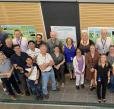
Showing 81 - 100 of 232 results
When solar radiation grounds our planes....
Radiation testing of electronic components at ANTO could benefit the aviation industry, regulators and most importantly, passengers as solar radiation events increase.
ANSTO User Meeting 2023 - Awards
You are invited to submit to the various awards from ANSTO, User Advisory Committee (UAC) and Australian Neutron Beam User Group (ANBUG).
World Environment Day 2019. Beating air pollution
Today is World Environment Day, a United Nations initiative for encouraging worldwide awareness and action for the environment. This year’s theme is “Beat Air Pollution”, a call to action to combat this global crisis.
Surface coatings on Aboriginal rock art provide insights into climate environment
Radiocarbon measurements at ANSTO’s Centre for Accelerator Science have supported research published that provided insights into what the environment was like for the Aboriginal artists who created rock art over intervals spanning 43,000 years.

Our impact
Recent news, highlights, and impact case studies from CAS’ research and industry user communities and collaborations/partners

Role at ANSTO
NSW grants support infrastructure capabilities
NSW grants bolster additive manufacturing and groundwater processing capabilities.

Infrastructure - Aerosol Sampling
ANSTO has been using Ion Beam Analysis (IBA) techniques to analyse fine particle pollution samples collected from key sites around Australia, and internationally, for more than 20 years.

Andrew Peele was appointed Group Executive for ANSTO Nuclear Science and Technology in July 2021 and was Director of the Australian Synchrotron from 2013 -2021. He is an adjunct Professor of Physics at La Trobe University.

Role at ANSTO
Scientific ingenuity + design powers challenge-based innovation
A 'Challenge-Based Innovation' platform at the nandin Innovation Centre is progressing as part of a funding package from the NSW Government and a Memorandum of Understanding with Swinburne University of Technology and Design Factory Melbourne (DFM).
Iron and Fire
Using geoarchaeology to reconstruct the history of an ancient Khmer city.

Radiation Testing - Expertise
The Centre for Acclerator Science operates accelerators that can be used for space radiation testing.
Energy use and emissions
Detailed data on ANSTO electricity use and CO2 emissions for FY2022 - FY2023
ANSTO helping to ensure the safety of astronauts in space
A team of ANSTO health researchers, staff at the Centre for Accelerator Science and Dr Melanie Ferlazzo, a postdoc from the French National Institute of Health and Medical Research (INSERM), and scientists from the French Space Agency (CNES), are collaborating on investigations to determine the impact of secondary particles on human cells using the new microprobe beamline at ANSTO’s Centre for Accelerator Science.

Understanding the biological response to radiation
Research is undertaken to characterise and optimise the beneficial impacts of radiation on living matter

Role at ANSTO

Surface engineering and materials modification
The Centre for Accelerator Science offers techniques for surface engineering and materials modification.